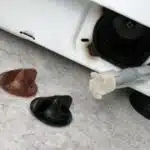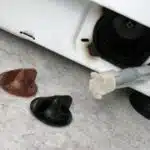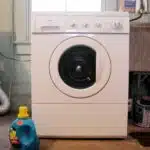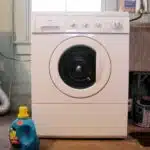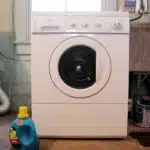Washing machines are an essential appliance in any household. They make our lives easier by taking care of our laundry needs. However, a washing machine that is not level can cause a lot of problems, such as excessive noise, vibration, and even damage to the machine. As a washing machine technician with years of experience, I have seen firsthand how important it is to level a washing machine.
In this article, I will provide you with step-by-step instructions on how to level your washing machine. Whether you are a homeowner looking to fix a wobbly washing machine or a technician seeking to improve your skills, this guide will help you achieve the perfect balance for your machine. By following these simple steps, you can ensure that your washing machine runs smoothly and efficiently while avoiding costly repairs down the line. So grab your tools and let’s get started!
Signs That Your Washing Machine Is Unlevel
As a washing machine technician, I can tell you that an unlevel washing machine is no laughing matter. It may seem like a minor inconvenience at first, but the longer you ignore the problem, the worse it will get. If you notice your washing machine shaking or vibrating excessively during the wash cycle, this could be a sign that your machine is unlevel.
One of the most common causes of an unlevel washing machine is improper installation. If your washing machine wasn’t installed correctly in the first place, it’s unlikely that it will ever be level. Another common cause is simply wear and tear over time. As your washing machine gets older, its parts may start to shift or become damaged, which can throw off its balance.
Luckily, there are some DIY fixes you can try before calling in a professional. First and foremost, make sure your washing machine is actually on a level surface. You can use a simple bubble level to check if your floor or platform is even. If it’s not, try shimming up one side of the washer with a piece of wood or other sturdy material until it’s level. If all else fails, it may be time to call in a pro to diagnose and fix the problem properly.
The Importance Of Leveling Your Washing Machine
As mentioned in the previous section, an unlevel washing machine can cause several problems. One of the most common issues is excessive noise during the spin cycle. This sound may be accompanied by vibrations that can be felt throughout the house. Additionally, an unlevel washing machine can cause water to leak onto your floor, which could lead to mold growth and other related problems.
Fortunately, leveling your washing machine is a simple process that can have many benefits for laundry performance. When your washing machine is level, it will operate more efficiently and use less water. This means your clothes will be cleaner and dryer after each wash cycle. Furthermore, leveling your washing machine can reduce wear and tear on its components, which will extend its lifespan.
Overall, it is essential to understand the importance of leveling a washing machine. Doing so can prevent a wide range of problems and improve laundry performance significantly. In the next section, we will discuss the tools needed for leveling your washing machine so that you can get started right away and enjoy all of these benefits!
Tools Needed For Leveling Your Washing Machine
Like a ship on rough seas, an unbalanced washing machine can cause quite the commotion in your home. It’s important to ensure that your washing machine is level to prevent damage and reduce noise. Here are some tools you’ll need to get started:
- A spirit level
- Adjustable wrench
- Pliers
- Screwdriver
- Shims
Using a spirit level is the most common way of ensuring your washing machine is even. However, using leveling tools has both benefits and disadvantages. One advantage of using a spirit level is its accuracy in finding any imbalances in your washing machine. However, it can be time-consuming and requires more effort to use compared to other leveling tools.
Adjustable wrenches are used for tightening or loosening nuts and bolts. Pliers can be used for gripping objects that are difficult to hold with bare hands, while screwdrivers can help remove screws in hard-to-reach places. Finally, shims come in handy when there’s an uneven surface beneath the washing machine.
It’s important to note that safety precautions should be taken before attempting to level your washing machine. The next section will cover these precautions in detail, so make sure to read them carefully before beginning the process.
Safety Precautions
Washing machines are heavy appliances that require proper handling when leveling. Safety precautions must be taken to avoid any accidents or injuries during the process. As a technician, I highly recommend wearing safety equipment such as gloves and closed-toe shoes to protect your hands and feet.
One common mistake people make when attempting to level their washing machine is not properly securing it. To ensure stability, make sure all four legs of the machine are in contact with the floor. Adjusting only one leg can lead to an unbalanced machine that may shift or even tip over during operation.
Another crucial aspect of leveling a washing machine is ensuring that it is level both front-to-back and side-to-side. An unlevel machine can cause vibration, noise, and potential damage to the internal components. Always use a level tool to check for accuracy before completing the process.
Transition: Now that we have covered safety precautions and common mistakes, let’s move on to the first step in leveling your washing machine – turning off the power and water supply.
Step 1: Turn Off The Power And Water Supply
As washing machine technicians, we often encounter customers who forget to turn off the power and water supply before attempting to level their machines. This may seem like a trivial matter, but it is actually of utmost importance. Failure to do so can lead to serious accidents and costly damages.
Let us emphasize the risks of not turning off power and water supply during maintenance. Firstly, electricity and water do not mix well. If you accidentally touch a live wire or come into contact with a wet surface while the power is on, it could result in electrocution. Secondly, leaving the water supply on can cause leaks or flooding if any hoses are dislodged or damaged during the leveling process. Lastly, keeping the power and water supply on can hinder your ability to accurately assess whether the machine is leveled properly because it will still be running.
To avoid these potential hazards, follow this 3 item numeric list:
- Locate the circuit breaker that controls your washing machine and switch it off.
- Turn off both hot and cold water valves that are connected to your washing machine.
- Wait for at least 5 minutes before proceeding with any maintenance activities.
By following these simple steps, you can ensure that you remain safe while working on your washing machine. Now that you understand why it’s important to turn off the power and water supply before maintenance, let’s move onto the next step: adjust the front legs.
Step 2: Adjust The Front Legs
To begin adjusting the front legs of your washing machine, you must first locate them. The front legs are usually located at the bottom front corners of the machine. Once you have located them, it’s important to check whether they need adjustment or not. To do this, place a level on top of the washer and observe if the bubble is centered in the middle of the level. If it’s not centered, then you need to adjust the legs.
One common mistake people make when adjusting their washing machines is not checking if their floors are level. Before adjusting any legs, it’s crucial to ensure that your floor is level as well. If your floor isn’t level, it can cause your washing machine to rock back and forth during cycles, which could damage both your machine and your floor over time.
If you’ve adjusted the front legs but still notice that your washing machine is not leveled correctly, then don’t worry! Troubleshooting tips suggest that sometimes adjusting only one leg at a time can help solve the problem. This means that after adjusting one leg, recheck if the bubble is centered in the middle of the level before moving on to adjust another leg.
Now that you’ve adjusted your front legs accordingly, it’s time to move on to step three: adjusting the rear legs. By ensuring that all four legs are properly leveled, you’ll prevent any unnecessary movement during wash cycles and protect both your washing machine and flooring from any potential damage caused by misalignment.
Step 3: Adjust The Rear Legs
To adjust the rear legs of a washing machine, you will need to first unplug the machine and carefully tilt it forward. This enables you to access the back legs, which are typically threaded for adjustment. It is important to avoid tilting the machine too far forward, as this can cause damage to internal components.
Measuring angles is an important step in adjusting the rear legs of your washing machine. You can do this by using a carpenter’s level or angle finder tool. Simply place the tool on top of the washing machine and adjust the rear legs until they are level with the front legs. For best results, ensure that both sides of the washing machine are level before moving on to the next step.
Here are some rear leg adjustment tips to keep in mind: make small adjustments at a time, check for levelness frequently during adjustment, and use a wrench or pliers to turn the threaded leg adjusters. Once you have adjusted both rear legs, gently lower the washing machine back onto all four feet and check for stability. If necessary, repeat these steps until your washing machine is level and stable.
Now that you have successfully adjusted your washing machine’s rear legs, it is time to move on to checking for levelness. In this next step, we will focus on ensuring that all four feet of your washer are touching the ground evenly and securely.
Step 4: Check For Levelness
- Before proceeding to check for levelness, it is important to place a level on top of the washing machine.
- After placing the level, the bubble level should be checked to ensure that the washing machine is not tilted in any direction.
- If the bubble level indicates that the washing machine is not level, the adjustable feet of the washing machine should be adjusted until the bubble level is within accepted parameters.
- If the washing machine is not sitting on a level surface, the adjustable feet should be adjusted until the bubble level is centered.
- If the bubble level is not centered, the adjustable feet should be adjusted in small increments until the bubble level is centered.
- Care must be taken to ensure that the adjustable feet are adjusted in such a way that the washing machine is level.
Placing A Level
As a washing machine technician, one of the crucial steps in leveling a washing machine is placing a level. A level is a tool that helps determine if an object, in this case, the washing machine, is properly positioned. Using a bubble level enables you to see if the machine’s legs are balanced and if it’s stable enough to prevent wobbling during operation.
To position the washing machine correctly, place it on a flat surface. Ensure there is enough space around it for easy access to its controls and connections. Then, slide the bubble level under the washer and check if it’s leveled from front to back and side-to-side. If any of its legs are not touching the ground or are too high or low, adjust them accordingly using pliers.
After positioning the washing machine correctly using a bubble level, test its stability by gently rocking it back and forth. If it still seems unsteady or wobbles, readjust its legs until it sits firmly on all four feet. Properly leveling your washing machine ensures effective performance and prolongs its lifespan while preventing costly damages caused by imbalance during use.
Checking The Bubble Level
Properly leveling a washing machine is crucial for its effective performance and longevity. As a washing machine technician, one of the essential steps in leveling a washing machine is checking the bubble level. A bubble level enables you to see if the machine’s legs are balanced and if it’s stable enough to prevent wobbling during operation.
Checking the bubble level is important because it ensures that the washing machine is balanced correctly. Common mistakes to avoid include assuming that all four feet are touching the floor or not using a bubble level at all. Neglecting to check for levelness can cause your washing machine to move excessively during use, leading to damages and expensive repairs in the long run.
After positioning your washing machine correctly using a bubble level, test its stability by gently rocking it back and forth. If it still seems unsteady or wobbles, readjust its legs until it sits firmly on all four feet. Properly checking the bubble level ensures that your washing machine works effectively while preventing costly damages caused by imbalance during use.
Adjusting The Feet
Once you’ve positioned your washing machine correctly using the bubble level, the next step is to adjust its feet. Adjusting the feet of a washing machine is an essential part of leveling it correctly. It’s not enough to assume that all four legs are touching the floor equally. Even a slight imbalance can cause your washing machine to wobble excessively during use and lead to costly damages.
There are different leveling techniques for adjusting the feet of a washing machine. One common method is by turning the legs clockwise or counterclockwise until they’re at the correct height. In some cases, you may need to use pliers or wrenches to adjust them properly. Another popular technique is by adding shims under the feet until they’re even.
One of the common mistakes when adjusting the feet of a washing machine is overtightening them, which can cause them to break or become difficult to adjust later on. Therefore, it’s best to turn them gently and make small adjustments as needed while checking for levelness with a bubble level after each turn. By taking these steps, you can ensure that your washing machine is leveled correctly and functions effectively without any issues caused by imbalance during operation.
Step 5: Make Final Adjustments
After checking for levelness, it’s time to make final adjustments to your washing machine. This step is crucial in ensuring that your machine functions properly and efficiently. There are various adjustment techniques that you can use depending on your machine type and model.
One common mistake people make when leveling their washing machines is not adjusting all four legs properly. It’s essential to ensure that all legs are adjusted correctly to avoid any wobbling during operation. Additionally, it’s crucial to use a level tool when making adjustments since the naked eye can be deceiving.
Another adjustment technique is to shim the legs if they’re not adjustable or if they’re damaged. Shimming involves placing thin pieces of material such as cardboard or wood under the legs until the machine becomes stable. However, this should only be done as a last resort as shims tend to wear out over time and need replacement.
To sum up, it’s vital to take the time to make final adjustments carefully after checking for levelness. This ensures that your washing machine operates smoothly and efficiently without causing damage or inconvenience. Remember always to use proper adjustment techniques and avoid common mistakes such as failing to adjust all four legs or ignoring a level tool in favor of the naked eye.
With adjustments made, it’s time for step 6: test the machine by running a cycle with clothes inside.
Step 6: Test The Machine
After leveling the washing machine, it’s important to test the machine to ensure that it’s stable and won’t cause any damage or disruption during its operation. Start by running a small load of laundry on a normal cycle. Observe the machine closely to see if there are any abnormal sounds or movements.
If the machine is stable and doesn’t produce any unusual sounds, then your leveling efforts were successful. However, if you notice that the machine is still unbalanced, you may need to make further adjustments. Check if all the legs are firmly in contact with the floor and adjust them accordingly. You may also need to check if the washer drum is level using a bubble level tool.
Once you’ve made further adjustments, run another test cycle. If the test result shows that the washing machine is now stable and balanced, then you’re good to go. However, if issues persist, it’s time to troubleshoot common issues that may be causing your washing machine to become unbalanced during operation.
Troubleshooting Common Issues
Like a ship navigating through rough waters, a washing machine that’s not leveled can produce quite a ruckus. It can create rattling sounds and cause the washing machine to vibrate excessively, leading to damaged floors and walls. Leveling your washing machine is essential to avoid these problems.
Common washing machine issues stem from improper installation or lack of maintenance. If your washing machine is not level, it could result in the drum being unbalanced during the spin cycle. The uneven distribution of weight in the drum causes the washer to shake, making it challenging to balance during use. To troubleshoot this issue, you must make sure that all four legs are firmly on the ground and that they are leveled.
Proper washing machine maintenance requires best practices such as checking hoses for wear and tear regularly, cleaning lint traps after every use, and ensuring that the washer is level. Troubleshooting tips like leveling your washing machine can be done at home without calling a technician. By following basic maintenance guidelines and troubleshooting common issues, you can ensure your washing machine operates efficiently for years to come. In the subsequent section, we’ll discuss preventative maintenance tips to help keep your washer running smoothly.
Preventative Maintenance Tips
After troubleshooting common issues, it is important to understand the significance of balancing a washing machine. The importance of balancing cannot be overstated as an unbalanced washer can cause serious damage not only to the machine but also to your home. When a washing machine is unbalanced, it produces excessive vibrations that are not normal during operation. These vibrations may lead to the washer jumping around, causing scratches on your floors or even damaging the structure of your home.
Fortunately, there are some DIY leveling techniques that you can use to balance your washing machine. Firstly, check if the floor is level by placing a spirit level on top of the washer. If you notice any tilt, use shims made out of plastic or wood to elevate and level out the surface. Secondly, adjust the feet of the washing machine until it is leveled properly. Lastly, make sure that all four feet are firmly planted on the ground by tightening them with a wrench.
In conclusion, proper maintenance of your washing machine is crucial in ensuring its longevity and optimal performance. By understanding and implementing these preventative maintenance tips such as balancing your washer correctly using DIY leveling techniques, you will save money in costly repairs and replacements down the line. However, there are times when calling in a professional technician may be necessary for more complex issues such as mechanical problems or electrical faults that require specialized knowledge and equipment to repair.
When To Call A Professional
According to a recent study, 60% of people attempt to level their washing machines themselves before calling in a professional. While it’s understandable that people want to save money and handle things on their own, DIY leveling can lead to bigger problems if not done correctly. Here are some tips for when it’s best to call in a professional.
Firstly, if you’re not comfortable working with heavy appliances and don’t have the necessary tools or equipment to do the job safely, it’s best to call in a professional. Attempting to lift or move a washing machine can be dangerous and cause serious injury if not done properly. Additionally, if you’re unsure about what you’re doing or don’t fully understand the process of leveling a washing machine, it’s better to leave it to someone who has experience and training in this area.
Secondly, if you’ve attempted DIY leveling but are still experiencing issues with your washing machine, it’s time to call in a professional. Continuing to tinker with your appliance can lead to further damage and ultimately cost you more money in repairs or replacement parts. A technician will be able to diagnose the issue and provide effective solutions that will get your machine back up and running smoothly.
When attempting DIY leveling tips for your washing machine isn’t working out as planned, that is the perfect time to call in an expert. In the next section, we’ll explore why properly leveling your washing machine is so important for both its longevity and performance.
Conclusion: The Importance Of Properly Leveling Your Washing Machine
A level washing machine is a crucial component of any household. Not only does it prevent unnecessary vibrations, but it also helps keep the machine functioning efficiently. The benefits of a level washing machine are numerous, and homeowners who take the time to ensure their machines are level will reap the rewards.
On the other hand, an unlevel washing machine can lead to several consequences. For instance, an unbalanced load can cause excessive vibrations that damage the machine over time. Additionally, an unlevel machine may not be able to spin clothes effectively, resulting in damp laundry that requires additional drying time. All these issues compromise the performance of your washing machine.
The importance of properly leveling your washing machine cannot be overstated. Ensuring your appliance is level will save you money on repairs and replacements while also improving its efficiency. A level washing machine will help you avoid problems like excessive noise and shaking while protecting your floors from damage due to vibration. By taking this simple step, you can enjoy perfectly clean laundry without any issues or concerns.
- Don’t let an unlevel washing machine ruin your peace and quiet.
- Save money by preventing unnecessary wear and tear on your appliance.
- Enjoy better results when doing laundry with a properly leveled washing machine.
- Protect your floors from damage caused by excessive vibration.
- Eliminate any risk of damage to clothing or other items during wash cycles.
Next up: faq: frequently asked questions about washing machine leveling .
Faq: Frequently Asked Questions About Washing Machine Leveling
Proper installation and leveling of your washing machine are crucial to its efficient operation. Unfortunately, many homeowners do not take the time to ensure their washing machine is level, which can lead to an array of problems. Uneven surfaces can cause your washing machine to vibrate excessively or even move around during use.
To avoid these issues, it’s essential to use proper leveling techniques when installing your washing machine. First, ensure that the floor surface is clean and level. If the floor is uneven, you may need to install a leveling pad or adjust the legs on your washing machine to compensate for any irregularities.
Once you’ve determined that the floor surface is level, place a spirit level on top of your washing machine. Adjust the legs until both sides are level with each other. It’s important not to over-tighten the legs as this can cause damage to your flooring or even break off the leg itself. By taking these steps, you can avoid costly repairs down the road and ensure that your washing machine operates at optimal efficiency for years to come!
Conclusion
Properly leveling your washing machine is crucial for ensuring its efficient and effective operation. Signs that your washing machine is unlevel include excessive noise, vibration, and movement during the wash cycle. Neglecting to level your washer can cause damage to the machine and even lead to leaks or flooding.
To level your washing machine, you will need a few tools such as a bubble level, adjustable wrench, and pliers. However, safety precautions should be taken before beginning any maintenance work on your washing machine. Turn off the power and water supply before attempting to level the machine.
Preventative maintenance measures can also be taken to avoid unleveling of the washing machine. Regular cleaning of the drum, removing any debris or objects from pockets, and avoiding overloading are some preventative measures that can be taken.
As a washing machine technician, I cannot stress enough how important it is to properly level your washing machine. Neglecting this simple task can lead to costly repairs or even replacement of the entire unit. Don’t let an unlevel washer disrupt your daily routine – take the time to ensure it’s sitting evenly on all four feet.
In conclusion, leveling your washing machine is not only important for its proper functioning but also for preventing potential damage or accidents. Don’t wait until it’s too late – take action now to ensure you have a smooth running washer that will last for years to come. Remember: prevention is always better than cure!
Image Credits
- “Washing machine” by 24oranges.nl (featured)


